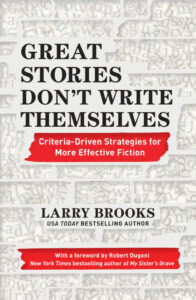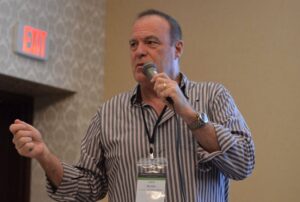by
Today, I’m delighted to talk with former TKZ contributor, Larry Brooks, about his new craft book, GREAT STORIES DON’T WRITE THEMSELVES, with a foreward by mega-bestseller Robert Dugoni. Larry’s book launches on October 8, 2019, published by Writer’s Digest Books.
Welcome back to the Zone, Larry!
DB: You’ve written three successful books on fiction craft–Story Engineering, Story Physics, and Story Fix—each with a strong emphasis on the architecture of story structure. What new ground are you digging into for this latest book?
LB: Each of my writing books sought to bring clarity and order to what one might call the conventional wisdom of writing a novel, which is anything but clear. Within that so-called conventional wisdom there is legitimate imprecision, alongside unfortunate confusion born of contrary interpretations and polarizing preferences. Because of this, there remains a high degree of risk and a frighteningly high frequency of failure. Over 96 percent of novels submitted by agents are rejected at least once. That’s not exactly irrefutable statistical proof that the conventional wisdom serves everyone well.
That said, those who claim “there are no rules” are only adding to the noise and confusion. Frustration resides in the grey area between rules and principles, and between the separate contexts of process versus product. So much of what we hear and read about “how to write a novel” connects to process (how your favorite author does the work may or may not be a process that works for you). This leaves the realm of product – what a novel consists of, the criteria for efficacy, and how to know if you’ve come anywhere near close enough to meeting those criteria as largely untended ground. It’s as if the unspoken common courtesy suggests that you can write anything you want, any way you want, and you’ll be fine… if you “just write.”
That 96-percent failure statistic proves this to be false. My new book – “Great Stories Don’t Write Themselves: Criteria-Driven Strategies for More Effective Fiction” is process-neutral, yet it culls out and assigns specific criteria for each and every element and essence of a novel across the entire structural, dramatic and character arcs involved. No matter how you get there.
Too often writers don’t know what they don’t know, while believing they do know enough, or what they think they know is unimpeachable. My new book seeks to shrink the gap between those extremes.
DB: Sounds like an ambitious goal. Can you give us an example?
LB: Sure. When was the last time you heard anyone at a writing conference – a speaker, teacher, agent or even another writer in an elevator, tell someone that their story idea isn’t strong enough? Never happens. And yet, as much as half of all rejection connects to story ideas that are derivative, vanilla and flat, that are lacking the raw grist of what makes a story work. Ask any agent or editor how many of the story ideas that cross their desk excite them, how often this happens, and this truth will be verified.
But it’s not just the story idea that matters. Whether it’s the core premise, the opening scene or sequence, the first plot point or the midpoint or the way the character and her/his core quest is framed… all of it becomes more accessible and effective when developed and evaluated in context to criteria that are universally applicable to that specific element.
DB: Where did the germ of the idea for Great Stories come from?
LB: I pondered that 96-to-4 failure rate, and decided there had to be a better way forward. After writing three books on storytelling that began exploring this sad truth, the subsequent question of “now what?” wouldn’t let me alone. How and why are those 4-percent of submissions that succeed better than the 96-percent that aren’t working as well? What are the common denominators of that?
My favorite writing tip is this: scenes work best once we understand the narrative expositional mission of the scene, in context to what came before and what comes next. This is why we rewrite and revise, to get closer and closer to that optimal form. From that epiphany, I came to realize this is true for all of the structural, thematic and aesthetic elements of a great story, at all levels. We are either searching for our best story, or we are polishing (optimizing) scenes toward that standard. That said, too many writers aren’t writing toward a standard at all, they are simply writing down what seems to be available in the moment of creation. They are just writing.
The more we understand the available criteria that will apply to a story that reaches the high bar of optimal efficacy, the sooner and more blissfully we will arrive there. That objective became the mission of my new writing book.
DB: What’s the most important concept or lesson you hope to teach writers with your new book?
LB: You don’t have to guess, nor do you have only your instincts to inform your choices. Your story choices can be informed by the criteria that will apply, one way or another, to the determination of what works and what doesn’t. These criteria apply within any and all writing processes, readers don’t give two hoots how the writer got it done. What does matter is the degree to which our choices align with what readers want, expect and have learned to recognize as emotionally resonant, thrilling and rewarding. That’s what talent really means: the consistent ability to land on the best possible ideas, and then make them shine on the page. When either of those outcomes happen—they are different core competencies, by the way, meaning we need to develop our craft on two levels, as storytellers and as scene writers—they are always framed by criteria that explains why they work. The book defines, explores and verifies over 70 separate criteria that apply within 18 specific facets or locations within the entirety of a novel’s narrative arc.
DB: What’s next on Larry Brooks’ “To Do” list? Is there a new thriller simmering on the back burner?
LB: I promised my wife I’d write her a love story, and in my mind the best love story is a thriller, because so much is at stake… stakes being a key criteria in any genre. Setting it in France won’t hurt, either.
Thanks for having me back here on The Kill Zone. I can be reached through my website, www.storyfix.com, where you can learn more about this book and any of my other work, including my fiction.
~~~~~
Thanks for sharing the inside scoop with us, Larry.
I, for one, will be looking forward to your love story thriller!
Great Stories Don’t Write Themselves is available for pre-order at:
~~~~~
TKZers: Do you have questions for Larry about his new book and/or story structure?



Larry, your first three books (Engineering, Physics, and Fix) were very helpful for me when I was digging into understanding story structure. I look forward to reading your new book in October. I have it on pre-order.
Good luck with your book!
Steve, Larry will appreciate your pre-order and good words about his other excellent guides.
Hey Steve – I appreciate your kind words, and am happy to hear you find the material helpful. Hoping the new book extends that experience for you. Thanks again – Larry
I had the honor of reading an ARC, and it’s amazing!!! Highly recommend for writers at all levels of craft.
Larry, get that love story done. I’ve been jonesing for a new Brooks thriller. 🙂
Sue, I also saw the ARC and it’s full of meaty information.
Larry, at least two of us are looking forward to the thriller love story!
Thanks to you and Debbie for your support. And, for “getting it.”
Larry
Welcome back to TKZ, Larry. We speak the same language (not French, BTW). Good luck with the book!
Hey Jim – always good to connect with you. You’re right, we not only speak the same language, we’re on the same page for almost the whole storytelling enchilada. I’ve learned a lot from you, and appreciate how supportive you’ve been. Still have that pic from the WD Pasadena conference a few years ago, we look like 6’5″ bookends.
I made my preorder of Larry’s new book. And I’m looking forward to the inside info on moving into the 4% zone.
Hey Suzanne – I appreciate that! Hope you find the key in those pages. Wishing you well! Larry
Welcome back Larry – I know your new book will be full of great advice and I am looking forward to the love story thriller!
Pingback: An Interview... With Content About the Writing Journey - Storyfix.com